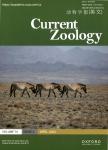Interspecific differences in plasma carotenoid profiles in nestlings of three sympatric vulture species
作者机构:Department of Evolutionary EcologyMuseo Nacional de Ciencias Naturales(CSIC)Jose Gutierrez Abascal 228006 MadridSpain Departament of Food PhytochemistryInstituto de la Grasa(CSiC)Campus Universidad Pablo de Olavide41013 SevilleSpain
出 版 物:《Current Zoology》 (动物学报(英文版))
年 卷 期:2023年第69卷第6期
页 面:658-669页
核心收录:
学科分类:0710[理学-生物学] 07[理学] 071002[理学-动物学]
基 金:Research was funded through projectsCGL2007-61395,CGL2010-15726,CGL2013-42451-P PID2019-109685GB-100 of the Spanish Ministry of Science and Innovation。
主 题:avian scavengers carotenes coloration feeding habits micronutrients xanthophylls
摘 要:Carotenoids are diet-based micronutrients important in health and coloration signaling.Related species with similar diets can differ in the kinds and levels of circulating carotenoids,which suggests specific physiological mechanisms to efficiently utilize these micronutrients,regardless of their availability.We explored whether diet and parental provisioning of unusual sources of carotenoids(fresh vegetal matter and vertebrate feces)can explain the occurrence and concentrations of carotenoids in the cinereous vulture Aegypius monachus,griffon vulture Gyps fulvus,and Egyptian vulture Neophron percnopterus nestlings,even when these pigments appear to not be deposited in their integumentary system.A greater diversity of wild prey in diet could be behind the profile of higher concentrations of carotenoids in the Egyptian vulture,the species with carotenoid-dependent coloration during adulthood,while differences in diet composition between cinereous and griffon vultures do not translate to different carotenoid profiles.The carotenoid profile appears to not be related to the ingestion of unusual matter rich in these compounds,although the infrequent occurrence of lycopene and unidentified y-carotene-like compounds suggest that these vultures may be exploiting vegetal matter that left no identifiable unconsumed remains in the nest of Egyptian vultures.The consumption of green plant material by griffon vultures does not result in especially high levels of carotenoids when compared to the carotenoids found in cinereous vultures,which do not consume green plant material.Ungulate feces were not provisioned to Egyptian vulture nestlings,despite the fact they contain carotenoids that adults need for appropriate coloration.Overall,this study indicates that diet differences alone appear insufficient to explain contrasting inter.specific carotenoid profiles,especially since all types of food consumed are considered to be poor in carotenoids,except vegetable matter.We suggest that nestling Egyptian vultures are comparatively efficient in uptaking carotenoids present in low concentrations in food when these compounds are not deposited in their integument,which suggests allocation to other functions.



